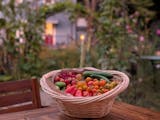What an awesome group of people who are helpful and give great advice and produce great informative videos! Thank you!
Love my new beds! Also the 5 tier planters are pretty awesome as well. Can’t believe how much they hold. Plenty of depth in each pocket for root growth. Looking forward to next spring to fill the new beds!
The team is absolutely amazing and if you ever have any concerns they are there to help sort it! James has built a community of great individuals all helping each other out! Happy growing! 💚🌱
I can’t say enough great things about Team Grow. The products are wonderful. The fertilizer is incredible, and my peppers are looking great, and are overloaded for the end of season. But what’s more important is the customer service, and an email that’s always answered.

















































































































